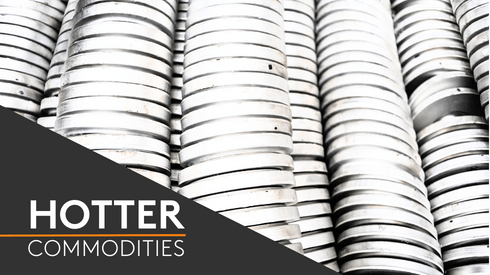In the face of these challenges, the EU’s landmark Critical Raw Materials Act (CRMA) is “without teeth,” Burkhard Straube, chief executive officer of Norway-based Vianode, told Fastmarkets in an interview on Tuesday June 6.
The CRMA officially came into effect on May 23 and aims to secure the EU’s critical raw material supply chains.
Norway is not a member of the European Union but is a member of the European Economic Area (EEA), which grants it access to the EU internal market on equal terms with member states.
“The US and China are not abiding by fair trade rules anymore, while we are. In the end this means Europe will lose out,” Straube said.
Starting full-scale production in the second half of this year, Vianode’s plant will have initial synthetic graphite capacity sufficient for roughly 2 GWh, or enough to supply 25,000-plus electric vehicles (EVs) per year, according to the company’s estimates.
But Europe’s battery raw material producers, and particularly those producing anode materials, require protection and support above what existing legislation offers, Straube argued.
“We expect synthetic graphite demand from EVs in Europe to be at least 300,000 tonnes by 2029 – more than double the 2024 figure,” Fastmarkets analyst Georgi Georgiev said.
“I never thought I would be a proponent of trade barriers and duties, but I think that nascent industries like ours do need substantial support and protection,” Straube told Fastmarkets.
The CRMA includes various measures intended to streamline regulatory hurdles for new projects and proposes a framework by which member states could coordinate the establishment of strategic stockpiles.
But for Straube, the Act falls well short of what will be needed to properly support the nascent sector in Europe to achieve the lofty production targets it established.
As a portion of overall capacity, the CRMA calls for domestic extraction capacity to reach 10% of overall EU strategic material consumption, for “intermediate processing steps” a 40% capacity of consumption, and a recycling capacity of 25% of overall consumption. It also called for no more than 65% of annual supply of any strategic raw material to come from any single third country.
But Straube doubted that the Act would make Vianode do anything substantially differently.
He stated that while the Act could be a boon to demand for domestically produced critical raw materials, it falls short of fostering improved supply. Indeed, the Act failed to introduce any new financing mechanism to support local production.
“On the supply side, we need to make it attractive to incentivize and build synthetic graphite capacity in Europe and that’s not being done,” he said.
And though the CRMA classifies synthetic graphite as “strategic,” it indicates that this will be reassessed in three years, threatening to hamper the development of a local supply chain in Europe, according to Georgiev.
The classification was nonetheless welcomed by Corina Hebestreit, secretary general of the European Carbon Graphite Association.
But particularly in light of recent US support schemes and regulatory framework, as well as China’s scale and experience advantage in synthetic graphite production, Straube questioned the competitiveness of Europe’s industry, arguing that for it to close the economic and technology gap with China, European producers need to be supported and temporarily protected.
European policy makers and industry participants are increasingly vocal about the impact of China’s plentiful exports to the rest of the world. In April, the European Union’s anti-trust chief warned that China’s clean tech export strategy was jeopardizing Europe’s economic strategy.
Europe is almost completely reliant on China for its supply of anode-grade graphite and late last year, the latter introduced export controls on the material, which many saw as threatening Europe’s access to the material, which underpins the EV transition.
Over 95% of synthetic battery anode-grade graphite is produced in China, according to Fastmarkets research.
“China has very good and well-developed synthetic graphite production capacities and for us to compete we must be allowed to catch up,” Straube said.
Extensive US subsidies for critical material production, including those introduced via the Inflation Reduction Act (IRA), have also led some producers to pivot from targeting the European market to targeting the US market.
“Whether we look at OEMs, cell manufacturers or anode and cathode manufacturers, it’s black and white – many moved to America or prioritized US projects,” Straube said.
On a more optimistic note, Europe’s battery regulation, which will introduce the requirement for battery producers to disclose emissions from their production, could boost demand for Vianode’s anode material, Straube said.
A Life Cycle Assessment of the Vianode’s production process indicated a climate change impact of 1.9 kg of carbon dioxide (CO2) equivalent per kg of graphite produced, marking a dramatic improvement compared with more mainstream graphite production that uses 10-40 kg CO2 equivalent per kg graphite produced, he said.
But any provided emissions figures should be verifiable and potentially provided by an independent third party, which will guarantee a level playing field, he said.
More generally, Straube emphasized that European financial support for graphite so far has focused on fostering innovation, while equivalent US legislation has instead targeted scale.
“Support in Norway and the EU has so far focused on technological development, which was and is very important, but what we are missing in Norway and in the rest of Europe is really scaling support, which the US IRA provides,” Straube said.
Participants in other sectors, including silicon-based anodes, have also warned that Europe’s neglect of fostering scale has risked the sector’s production falling behind the US.
Straube is very positive regarding Vianode’s development and opportunities, believing the market in North America to be highly attractive and interested in Vianode providing IRA-compliant and sustainable anode material.
The company plans to open a large-scale facility in North America in the second half of the decade with the target to thus contribute to the decarbonization of three million EVs by 2030.
Want to find out more about our critical minerals price data, forecasts and market insights? Head to our critical minerals hub today.






